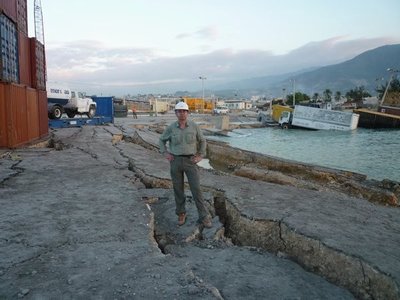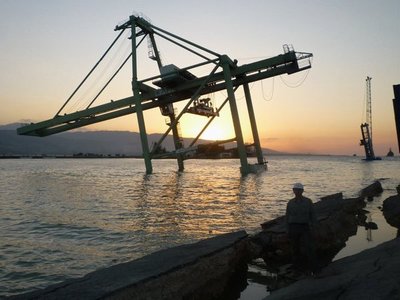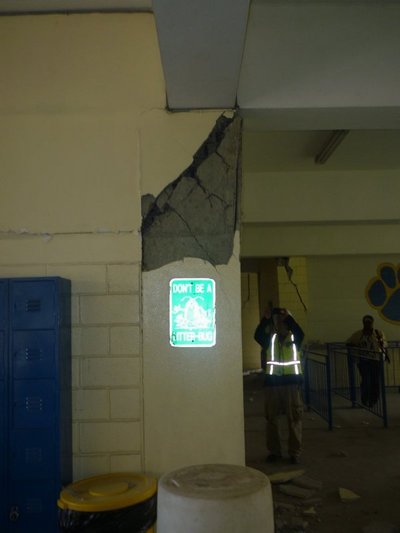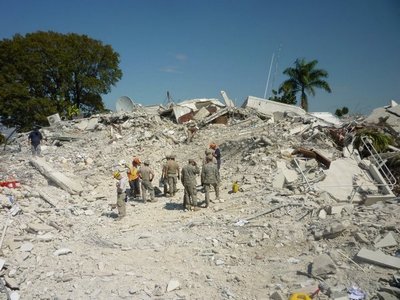February 11, 2010
UW earthquake engineer assesses damage in Haiti
The UW’s Marc Eberhard, a professor of civil and environmental engineering, led a five-person team sent to evaluate damage from the devastating magnitude-7 earthquake that struck Haiti on Jan. 12.
The team, sponsored by the national Earthquake Engineering Research Institute, provided engineering support to the United States Southern Command, which is responsible for all U.S. military activities in South and Central America. It also responded to engineering requests from the United States Agency for International Development.
The team found no surface evidence of the fault that might have caused the quake, but installed four instruments to measure aftershocks and help pinpoint the epicenter.
Assessing an earthquake’s magnitude can be done from afar, Eberhard said, but establishing the location requires several stations fairly close to the earthquake’s center. Such monitoring stations were not present in Haiti, he said.
Knowing the location will help understand what caused the earthquake and forecast the likelihood of future quakes in the area, he added.
The team provided a ground assessment of places that were worst hit, including the port in Port-au-Prince, the cathedral, the National Palace, the Hotel Montana and the Union School, attended by children of many nationalities. They photographed damage in smaller towns and assessed the safety of hospitals, schools, bridges and other critical facilities.
“A lot of the damaged structures will have to be destroyed,” Eberhard said. “It’s not just 100 buildings or 1,000 buildings. It’s a huge number of buildings, which I can’t even estimate.”
Many people asked team members to inspect buildings where the occupants were camped outside because they feared a collapse.
“There’s an enormous amount of fear,” Eberhard said. “People may see cracks in their houses. A large part of what we were doing was identifying what was serious damage versus what was cosmetic damage.”
“Probably the most satisfying thing we did would be to walk through the building and get people back inside.”
Eberhard traveled into Port-au-Prince on a military airplane on Jan. 26. He and other team members camped in front of the U.S. embassy during the weeklong trip.
The group kept a blog of the trip. Eberhard says he omitted some of the most disturbing images because members of his daughter’s 2nd-grade class were reading the posts.
This is not the first such assignment for Eberhard, who did reconnaissance after major earthquakes in California, Seattle, Taiwan and Costa Rica. But he says this was the most difficult on a personal level.
“Usually when I go to earthquakes I find that the amount of damage is less than what appears on the television,” Eberhard said. “In this case it was much more.”
“The main reason for that is usually when you see earthquake coverage the cameras will focus on one place that’s really damaged, and you don’t realize that around it there’s plenty of things that are just fine. In this case, the cameras focused on one place that’s really damaged, but because the cameras have a limited field of view you don’t realize that the cameras could be panned 360 degrees and you would see the same thing.”
The poverty of the people combined with the density of population and lack of building codes resulted in the widespread devastation, he said.
The group is writing a report of its findings and another team of engineers is scheduled to travel to Haiti on Feb. 28.
The engineering community, working with the United Nations and United States Agency for International Development , are assessing the next steps, including translating into Creole documents that explain in simple words and pictures how to rebuild structures that will be earthquake ready.
Other members of last week’s reconnaissance mission were Steven Baldridge, a structural engineer at Baldridge and Associates in Honolulu; Justin Marshall, a structural engineering professor at Auburn University in Alabama; Walter Mooney, a seismologist at the U.S. Geological Survey in California; and Glenn Rix, a geotechnical engineering professor at the Georgia Institute of Technology. Funding was provided by the National Science Foundation, the Earthquake Engineering Research Institute, the Geo-engineering Extreme Events Reconnaissance, the Applied Technology Council and the Network for Earthquake Engineering Simulation.






